Nomura Research Institute Bundle
How Did Nomura Research Institute Shape the Global Business Landscape?
Delve into the Nomura Research Institute SWOT Analysis and uncover the fascinating story of Nomura Research Institute, a company that has profoundly impacted the financial and technological sectors. From its roots in post-war Japan to its current status as a global powerhouse, NRI's journey is a testament to strategic foresight and adaptability. Explore the key milestones and innovations that have defined the NRI history and its enduring influence.
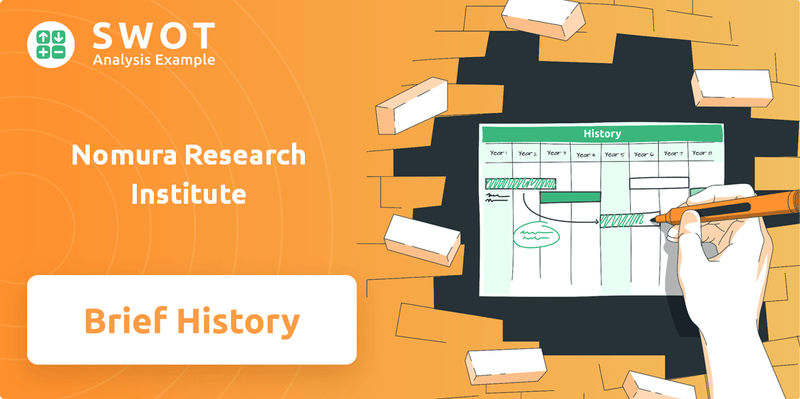
Understanding the brief history of NRI provides invaluable context for its present-day operations and future prospects. This exploration of the Nomura company will uncover how a Japanese research firm evolved into a leading provider of IT consulting and financial analysis services. Discover the key factors behind NRI's success, its global expansion, and its continued relevance in today's dynamic market.
What is the Nomura Research Institute Founding Story?
The story of Nomura Research Institute (NRI) begins with the research-focused ethos of the Nomura Group, which started in 1906 with a research department within Nomura Tokushichi Shoten. This dedication continued through Osaka Nomura Bank and Nomura Securities, leading to the publication of 'Capital Markets Research' in 1926, which is still published today. The official establishment of Nomura Research Institute (NRI) occurred in April 1965, marking Nomura Securities' 40th anniversary.
NRI was established as Japan's first comprehensive private think tank, spun off from Nomura Securities' Research department. This move reflected a commitment to innovation and the need for advanced financial and technological expertise in post-war Japan. The company's foundation was set to address critical challenges and opportunities in a rapidly changing society.
The establishment of the Electronic Data Processing Division of Nomura Securities Co., Ltd. in 1953, which later became the foundation of NRI's IT solutions business, was a pivotal moment. This division made history in 1955 by being the first in Japan to use a commercial computer, the UNIVAC-120, for business operations. In January 1966, Nomura Computing Center Co., Ltd. (NCC) was founded, later renamed Nomura Computer Systems Co., Ltd. in 1972. The goal of NCC was to apply the system development skills gained at Nomura Securities to streamline management and benefit various companies, showcasing a dedication to societal service and value creation.
NRI's founding prospectus highlighted its goal to be a 'new type of research institute that had never existed in Japan before,' with a core mission to 'promote industry and be of service to society through research studies.' This dual focus on research and societal contribution has been a central part of NRI's identity.
- NRI was established in April 1965, emerging from Nomura Securities' Research department.
- The Electronic Data Processing Division, formed in 1953, was a precursor to NRI's IT solutions.
- Nomura Computing Center Co., Ltd. (NCC), later Nomura Computer Systems Co., Ltd., was founded in 1966 to apply advanced system development expertise.
- The founding emphasized a commitment to research and societal contribution.
The creation of NRI as a joint-stock company, unlike many overseas think tanks, was a unique aspect of its founding. The economic and cultural context of post-war Japan, with its fast industrialization and rising demand for strong financial and technological infrastructure, significantly influenced NRI's formation. For more insights into the company's strategic development, you can read about the Growth Strategy of Nomura Research Institute.
Nomura Research Institute SWOT Analysis
- Complete SWOT Breakdown
- Fully Customizable
- Editable in Excel & Word
- Professional Formatting
- Investor-Ready Format
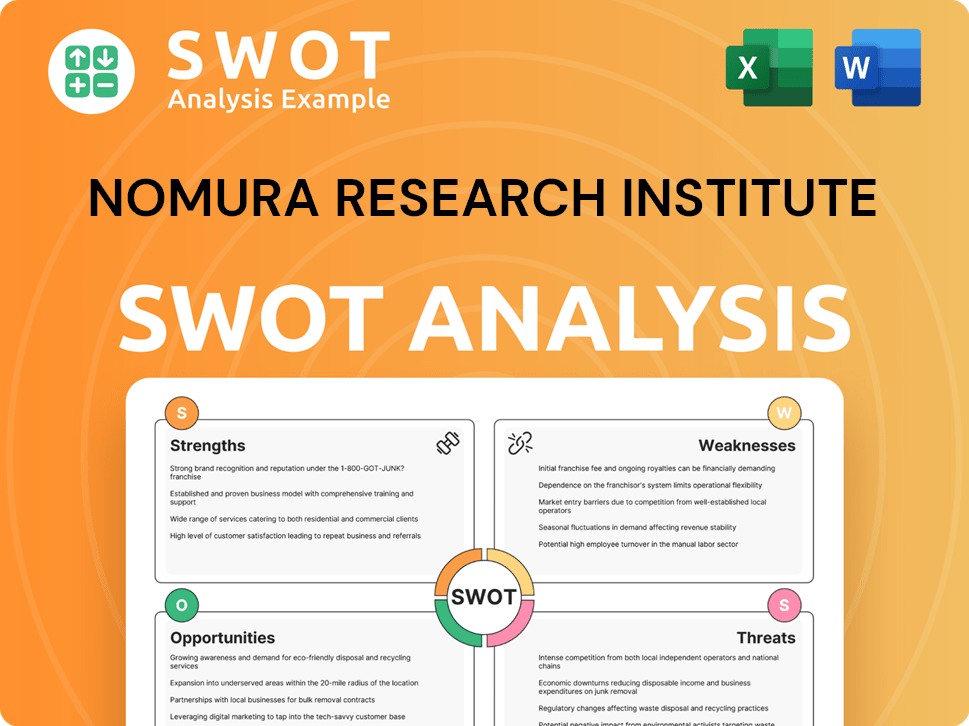
What Drove the Early Growth of Nomura Research Institute?
The early growth of Nomura Research Institute (NRI) was marked by strategic integration of research and IT capabilities. This approach led to significant milestones and a broadening global footprint for the Japanese research firm. From its inception in April 1965, NRI quickly expanded its international presence, establishing key offices worldwide. This expansion was crucial in establishing its global presence and influencing the financial markets.
NRI's global ambitions were evident early on. The company established its first overseas office in New York in January 1967, now known as Nomura Research Institute America, Inc. This was followed by the London Office in November 1972, now Nomura Research Institute Europe Limited, and the Hong Kong Office in January 1976. These ventures were pivotal in establishing NRI's global presence and shaping its future as a leading financial institution.
A significant milestone was the merger of Nomura Research Institute, Ltd. and Nomura Computer Systems Co., Ltd. in January 1988. This formed the current Nomura Research Institute, Ltd., transforming NRI into a comprehensive provider of research, consulting, IT solutions, and system operations. In May 1974, Nomura Computer Systems Co., Ltd. launched 'THE STAR,' a joint online back-office system for securities companies, followed by 'I-STAR' in October 1987, which were significant advancements in the financial technology landscape of Japan.
NRI continued to expand its geographical presence, establishing offices in Singapore (July 1984), Taipei (August 1994), and Seoul (April 1995). These expansions reflected the increasing demand for sophisticated IT solutions and strategic consulting. NRI's commitment to 'promote industry and be of service to society' remained a guiding principle, influencing its strategic shifts and continuous efforts to provide high-quality services. To understand more about the company's core values, you can read about the Mission, Vision & Core Values of Nomura Research Institute.
By 2001, NRI was listed on the Tokyo Stock Exchange. This move prompted the company to balance its social values with an increased emphasis on profitability. This transition marked a new phase in NRI's history, as it navigated the complexities of public markets while continuing to provide its services, including financial analysis and IT consulting. This period set the stage for its growth and evolution in the financial sector.
Nomura Research Institute PESTLE Analysis
- Covers All 6 PESTLE Categories
- No Research Needed – Save Hours of Work
- Built by Experts, Trusted by Consultants
- Instant Download, Ready to Use
- 100% Editable, Fully Customizable
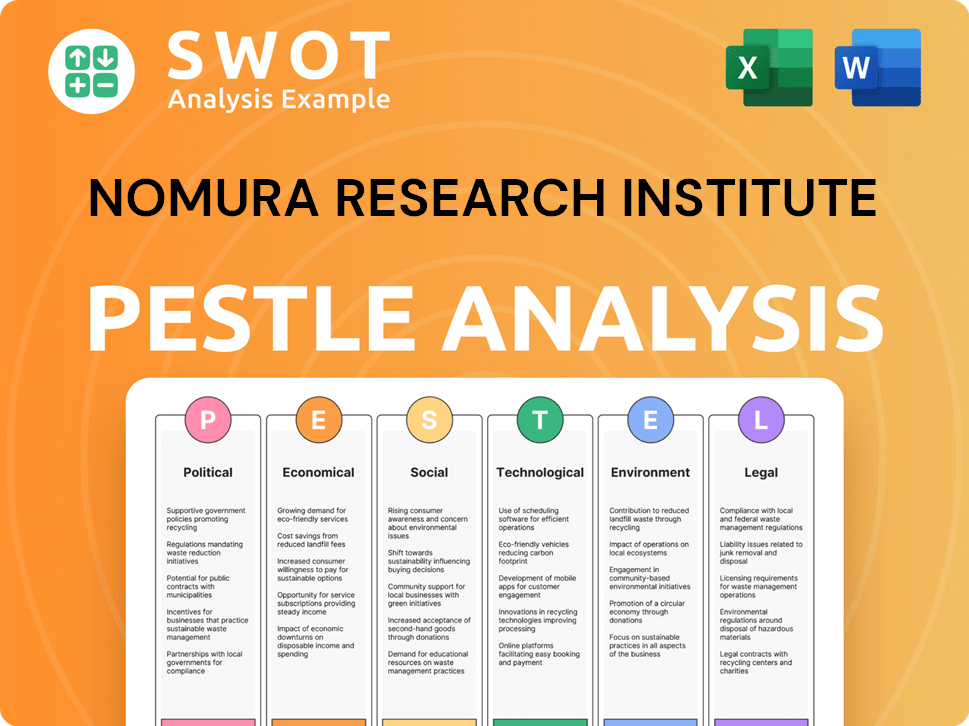
What are the key Milestones in Nomura Research Institute history?
The Nomura Research Institute (NRI) has achieved significant milestones throughout its history, establishing itself as a leading Japanese research firm. From its early adoption of technology to its pioneering IT solutions, NRI has consistently adapted and innovated within the financial and consulting sectors. This commitment to progress has solidified its position in the industry and shaped its trajectory over the years, making it a key player in the Japanese economy.
| Year | Milestone |
|---|---|
| 1955 | Nomura Securities' Electronic Data Processing Division, a predecessor to NRI, adopted the UNIVAC-120, marking an early use of commercial computers in Japan. |
| 1974 | Launched 'THE STAR,' a joint online back-office system for securities companies, a groundbreaking innovation. |
| 1987 | Introduced 'I-STAR,' a joint online back-office system for wholesale companies, enhancing its IT offerings. |
| 1993 | Launched T-STAR, a joint online back-office system for investment trust companies, expanding its financial IT solutions. |
| 2001 | Listed on the Tokyo Stock Exchange, prompting a re-evaluation of its balance between social values and profitability. |
| 2022 | Received the Grand Prize at the Sustainable Japan Award, recognizing its commitment to sustainable business practices. |
| 2025 | Plans to launch the 'NRI Financial AI Platform' in the first half of 2025, focusing on data privacy and security for financial institutions. |
| 2025 | Developed an innovative method for building industry- and task-specific Large Language Models (LLMs) in March 2025. |
Nomura Research Institute has consistently been at the forefront of technological advancements, particularly in the realm of IT consulting. The launch of the 'NRI Financial AI Platform' in 2025, powered by enterprise-grade AI models from Cohere, exemplifies its commitment to leveraging cutting-edge technology to streamline operations for global financial institutions. Furthermore, their innovative method for building industry-specific LLMs underscores their dedication to creating tailored solutions.
NRI's early adoption of commercial computers in 1955 set the stage for its future in IT solutions. This forward-thinking approach allowed the company to establish a strong foundation in the evolving technology landscape.
The development of joint online back-office systems like 'THE STAR' and 'I-STAR' revolutionized the financial industry. These systems improved efficiency and collaboration among financial institutions.
The launch of T-STAR in 1993 further solidified NRI's position in financial IT. This system catered specifically to investment trust companies, showcasing NRI's specialized expertise.
The planned launch of the 'NRI Financial AI Platform' in 2025 demonstrates NRI's commitment to innovation. This platform will leverage AI to enhance productivity and streamline operations.
In March 2025, NRI developed an innovative method for building industry- and task-specific Large Language Models (LLMs). This advancement highlights their focus on creating tailored solutions.
Receiving the Grand Prize at the Sustainable Japan Award 2022 underscores NRI's commitment to sustainable business management. This recognition highlights their dedication to societal contributions.
Throughout its history, Nomura Research Institute has faced various challenges, including adapting to evolving industry trends and market downturns. The company's listing on the Tokyo Stock Exchange in 2001 prompted a re-evaluation of its balance between social values and profitability, driving strategic shifts. To learn more about their market, you can read about the Target Market of Nomura Research Institute.
NRI has navigated several market downturns, requiring strategic adjustments to maintain stability and growth. These experiences have honed their ability to anticipate and respond to economic shifts.
The need to adapt to evolving industry trends has been a constant challenge for NRI. This has pushed them to continuously innovate and refine their services.
The listing on the Tokyo Stock Exchange in 2001 led to a re-evaluation of the balance between social values and profitability. This has influenced NRI's strategic direction.
NRI has pivoted to emphasize 'digital social capital,' focusing on social infrastructure built through its consulting and IT services. This shift reflects their commitment to societal impact.
As an organizer for the GX League for green transformation, NRI aims to launch emissions trading by 2026. This initiative demonstrates their dedication to sustainability.
NRI's financial consulting services have played a crucial role in guiding clients through complex market dynamics. Their expertise has been instrumental in helping clients make informed decisions.
Nomura Research Institute Business Model Canvas
- Complete 9-Block Business Model Canvas
- Effortlessly Communicate Your Business Strategy
- Investor-Ready BMC Format
- 100% Editable and Customizable
- Clear and Structured Layout
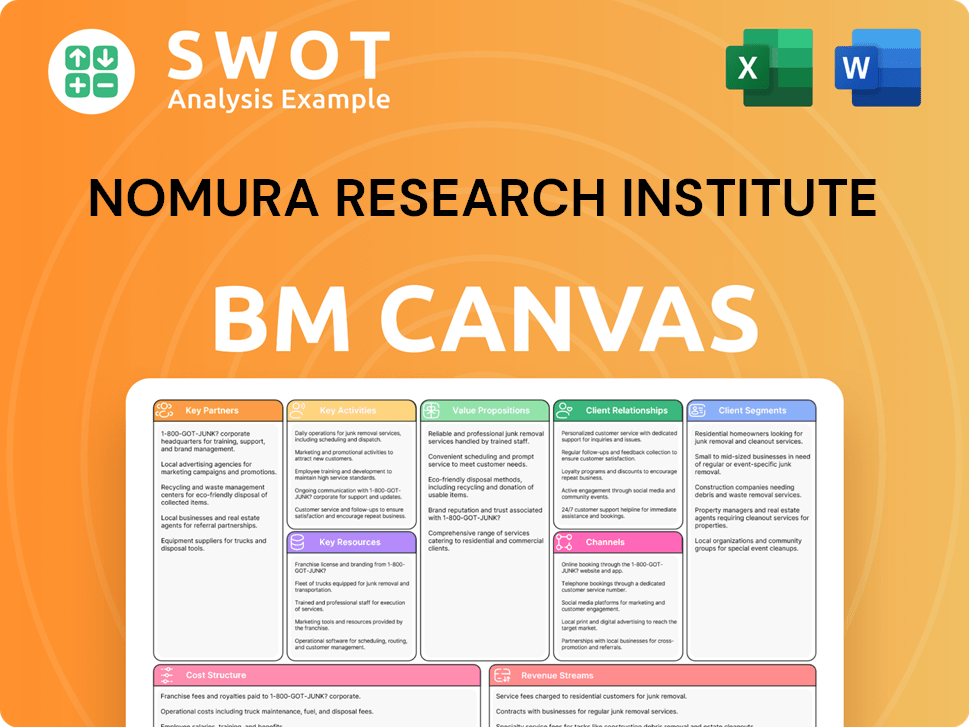
What is the Timeline of Key Events for Nomura Research Institute?
The Nomura Research Institute, or NRI, has a rich history that showcases its evolution from a research department to a global leader in consulting and IT solutions. This journey has been marked by several key milestones that highlight its growth and impact on the financial and technological landscapes.
| Year | Key Event |
|---|---|
| 1906 | Nomura Tokushichi Shoten establishes a dedicated Research department, marking the beginning of the company's research focus. |
| 1926 | 'Capital Markets Research' is launched by Nomura, a publication that remains active today. |
| 1955 | The Electronic Data Processing Division becomes the first in Japan to use a commercial computer (UNIVAC-120) for business purposes. |
| April 1965 | Nomura Research Institute (NRI) is founded as Japan's first full-fledged private comprehensive think tank. |
| January 1967 | The New York Office is established, which is now known as Nomura Research Institute America, Inc., representing NRI's first overseas office. |
| May 1974 | Nomura Computer Systems Co., Ltd. launches 'THE STAR,' a joint online back-office system for securities companies. |
| January 1988 | Nomura Research Institute, Ltd. and Nomura Computer Systems Co., Ltd. merge to form the current NRI. |
| October 1993 | T-STAR, a joint online back-office system for investment trust companies, is launched. |
| 2001 | NRI is listed on the Tokyo Stock Exchange. |
| August 2022 | NRI wins the Grand Prize at the Sustainable Japan Award 2022. |
| September 2024 | NRI announces collaboration with Cohere to launch the NRI Financial AI Platform. |
| December 2024 | The company introduces NRI STREAM. |
| March 2025 | NRI develops an innovative method for building industry- and task-specific LLMs. |
NRI's revenue in 2024 was ¥764.81 billion, reflecting a 3.84% increase from the previous year. Net income improved by 17.73% to ¥93.76 billion. The analyst consensus for Nomura Research Institute's EPS for the next financial year is ¥178.
The company plans to increase its consolidated dividend payout ratio from 35% (FY March 2023) to 40% for FY March 2026. NRI is focused on leveraging AI to enhance governance and convenience for customers, and is expanding its MultiCloud Strategy.
NRI is committed to sustainable finance, having been involved in the first green bond issuance by a domestic company in Japan in 2016. The company is actively involved in co-creating a thriving future society by driving new value, effectively utilizing resources, and advancing infrastructure.
The NRI Financial AI Platform is set to be rolled out in the first half of 2025. The company's stock price on May 16, 2025, reached a 52-week high of ¥6,039.00.
Nomura Research Institute Porter's Five Forces Analysis
- Covers All 5 Competitive Forces in Detail
- Structured for Consultants, Students, and Founders
- 100% Editable in Microsoft Word & Excel
- Instant Digital Download – Use Immediately
- Compatible with Mac & PC – Fully Unlocked
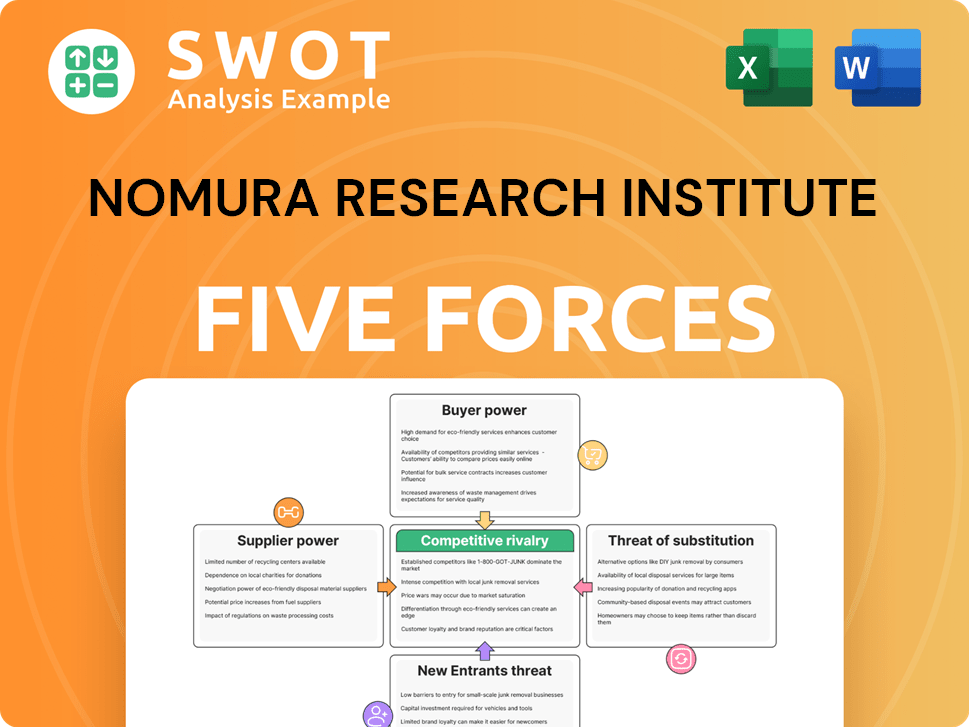
Related Blogs
- What is Competitive Landscape of Nomura Research Institute Company?
- What is Growth Strategy and Future Prospects of Nomura Research Institute Company?
- How Does Nomura Research Institute Company Work?
- What is Sales and Marketing Strategy of Nomura Research Institute Company?
- What is Brief History of Nomura Research Institute Company?
- Who Owns Nomura Research Institute Company?
- What is Customer Demographics and Target Market of Nomura Research Institute Company?
Disclaimer
All information, articles, and product details provided on this website are for general informational and educational purposes only. We do not claim any ownership over, nor do we intend to infringe upon, any trademarks, copyrights, logos, brand names, or other intellectual property mentioned or depicted on this site. Such intellectual property remains the property of its respective owners, and any references here are made solely for identification or informational purposes, without implying any affiliation, endorsement, or partnership.
We make no representations or warranties, express or implied, regarding the accuracy, completeness, or suitability of any content or products presented. Nothing on this website should be construed as legal, tax, investment, financial, medical, or other professional advice. In addition, no part of this site—including articles or product references—constitutes a solicitation, recommendation, endorsement, advertisement, or offer to buy or sell any securities, franchises, or other financial instruments, particularly in jurisdictions where such activity would be unlawful.
All content is of a general nature and may not address the specific circumstances of any individual or entity. It is not a substitute for professional advice or services. Any actions you take based on the information provided here are strictly at your own risk. You accept full responsibility for any decisions or outcomes arising from your use of this website and agree to release us from any liability in connection with your use of, or reliance upon, the content or products found herein.